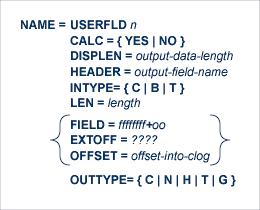The Adabas Review administrator can create up to five custom reporting fields. Portions of the command log and command log extension can be remapped using parameters to specify offsets and data types for these new fields.
This document covers the following topics that describe how to define custom reporting fields:
Field definition parameters are read from the RVUFLD data set at startup. Sample parameters are provided in member RVUFLD in the Adabas Review source library.

Each field is defined by a NAME statement followed by field description statements.
Possible values for the NAME statement are USERFLD1 through USERFLD5.
| Parameter | Values | Description |
|---|---|---|
| NAME | USERFLD1 through USERFLD5 | Field name that can be used in a report definition. . |
| CALC | YES | NO | Whether the field can be used for SUM, AVG, PCT, RATE. |
| DISPLEN | numeric | Length of the data when printed or displayed. |
| EXTOFF | ???? | ???? |
| FIELD | Two parameter values:
|
The name of an Adabas Review field, followed immediately by an optional
plus sign (+) and field offset value. No spaces should be specified around the
plus sign.
This is useful when you want to obtain the contents of a user field from part of the contents of an existing Adabas Review field. This parameter is mutually exclusive with the OFFSET parameter. The RDBLKUSR user field name is reserved for use with the REVUEX1 user exit. |
| HEADER | alphanumeric, 10-byte maximum | Title of the field when printed or displayed. |
| INTYPE | C (character) B (binary) T (time) |
Format of the data in the Adabas Review internal command log record, LORECR. |
| LEN | numeric | Length of the field in the Adabas Review internal command log record, LORECR. |
| OFFSET | numeric in decimal, not hex | Offset into the Adabas Review internal command log record, LORECR.
This parameter is mutually exclusive with the FIELD parameter. |
| OUTTYPE | C (character) N (numeric) H (hexadecimal) T (time) G (Gregorian date) |
Format of the data when printed or displayed. |
The FIELD, EXTOFF, and OFFSET parameters are mutually exclusive in a user field definition; only one of them may be specified. For example, suppose you wanted to define user field USERFLD1 as the last eight bytes of the communication ID. The communication ID can be accessed at either offset 88 (X'58') of LORECR or as the last eight bytes of the Adabas Review USERID field (which is 28 bytes long). You could define USERFLD1 in either of the following ways:
Using the OFFSET parameter: NAME=USERFLD1,OFFSET=88
Using the FIELD parameter:
NAME=USERFLD1,FIELD=USERID+20
The data types and lengths of each user field definition must be reflected in the DDM.
![]() To modify the DDM:
To modify the DDM:
Enter the Natural SYSDDM facility.
Edit the DDM
REVIEW-ADABAS-Vvrs -CLOG
Be sure to place "Y" in the REPLACE field.
Scan for user fields by entering on the command line
SC USER-FIELD
Modify the length and type of the fields
USER-FIELDn
Press PF11 to catalog the DDM.
The user fields you have defined are now ready to be used.
![]() To access the new fields either online or in batch:
To access the new fields either online or in batch:
Use the field names USERFLD1 through USERFLD5 as you would any other Adabas Review reporting field.
Important:
Before changing user-defined fields, carefully consider the
impact on existing reports and data. For example, if you were to create history
data for a particular report that uses USERFLD1 and then you change USERFLD1 to
represent different data, incorrect data would be added to the history report
the next time the report stored history data.
Modify the Adabas Review FDT.
Suppose you wanted to display the last eight characters of the 28-byte communication ID in a user field. You would first determine that communication ID is stored in LORECR field LOX1CMID at offset X'44' or a decimal offset of 68. So the offset of the last eight characters of the communication ID is at decimal offset 88.
The specification for the user field, USERFLD1, would look like this:
NAME=USERFLD1
LEN=8
INTYPE=C
OUTTYPE=C
OFFSET=88
*----------------------------------------------------------------------*
* OFFSET=X'58' = last 8 bytes of the communication ID in LORECR *
*----------------------------------------------------------------------*
DISPLEN=8
HEADER=LOX1CMID
CALC=NO
The specification for a report using the user field might look like this:
11:50:48 A D A B A S - R E V I E W 2009-05-26
Edit Report LOCL=00204
Detail/Summary: S
Report Name: RVUFLD45 - TEST OF LOX1CMID_____ DBID to Monitor: __204
+-----------------------------------------------------------------+
! Field Order Sum Min Max Avg Pct Rate Round !
!-----------------------------------------------------------------!
! SEQUENCE _10 _ _ _ _ _ _ ______ !
! DATE____ _20 _ _ _ _ _ _ ______ !
! TIME____ _30 _ _ _ _ _ _ ______ !
! CMD_____ _40 _ _ _ _ _ _ ______ !
! USERFLD1 _50 _ _ _ _ _ _ ______ ! |
The specification for the DDM might look like this:
11:43:22 ***** Edit DDM (ADA) ***** 2009-05-26 DDM Name REVIEW-ADABAS-V451-CLOG Def.Seq. DBID 255 FNR 241 Command I T L DB Name F Leng S D Remark - - - -- -------------------------------- - ---------- - - ------------------- S 3 EH USER-FIELD1 A 8 (1:7) |
The report might look like this:
11:49:23 RVUFLD45 - TEST OF LOX1CMID 2009-05-26
11:49:16 2009-05-26 Thru 11:49:23 2009-05-26 LOCL=00204
Page: 1
Sequence Date Time Cmd LOX1CMID
----------- ---------- -------- --- --------
4756 2009-05-26 11:49:16 V4 TSU23242
4757 2009-05-26 11:49:16 V4 TSU23242
4758 2009-05-26 11:49:16 S1 TSU23242 |